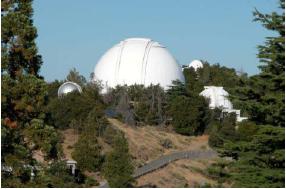California Vacation Astronomy Highlights
Dave Wagner
This August (2004) my wife and I went out to California on vacation. I would like to share two of our 'astronomical' events from our trip, a visit to the Lick Observatory located on Mt. Hamilton outside of San Jose, and a visit to Yosemite National Park in the Sierra Nevada Mountains. We thought the night sky from Mt. Hamilton was fantastic, but fantastic was totally redefined at Yosemite. I hope to encourage your future visit, as well as provide some guidance for your trip.
Part I - Lick Observatory
Lick Observatory, part of the University of California, is located on Mt. Hamilton, 14 miles east of downtown San Jose. The road from San Jose to the observatory, while paved, was narrow and winding (I've read there are 360 turns to originally accommodate a maximum 6.5 degree grade, to allow horse and mule drawn wagons to pull construction materials up the mountain when it was built from 1876 to 1887). The observatory is 4200 feet above sea level, typically above the level of the San Francisco fog.

One weekend a month, the observatory hosts a public 'Summer Visitor Program' on a Friday and Saturday night. I had applied for tickets in April, and via a lottery had been granted two tickets to the August 7 program ($5 each), which I received in the mail by June.
The facility is open to the public to tour until 5:00 p.m. We arrived late (remember that long twisty road?) and had only a short time to look around before the doors closed. We managed a quick look around, a visit to the 36-inch 'Great Lick' refractor (once the largest in the world), the 40-inch 'Nickel' reflector (also in the original observatory building), and a walk up the hill to Licks largest aperture telescope, the 120 inch 'Shane' reflector. The Shane telescope uses adaptive optics to correct for atmospheric turbulence, and is touted as the world's most prolific finder of extra-solar planets.
We fortunately brought our dinner along, so we then waited on the steps until the doors opened again at 7 p.m. for the evening program. For our patience we received numbers 1 & 2 for telescope observing, as we were the first two in line. About 240 folks were expected that evening, so we were glad we could go to the head of the line when it got dark.
There were two programs that evening, and they were each repeated once. One was on the history of James Lick and the observatory (presented by a historian) and the other was 'Cosmic Conundrum' by Dr. Koo of the University. Both were excellent.
By the time we had finished both programs, it was dark enough for some observing. We started with the 36-inch refractor in the larger dome, viewing an open cluster. We Lake County Astronomical Society Night Times Page 7 were moved into a dark waiting area in the upper part of the dome to dark adapt. Then we snaked down a metal stair case and about 1/2 way down the stairs, stepped over the low railing onto the raised floor of the observatory, raised up to put our eyeballs at the same height as the eyepiece of the telescope. The view was of course bright, with lots of color to the stars, but the FOV was a bit tight for the size of the cluster still leaving me impressed, but left me wanting to grab a lower power eyepiece...
After viewing and a few questions we returned to the staircase, over the low railing, and continued down to the bottom of the stairs, where dimly lit, with an arrangement of flowers in front of a brass marker, was the tomb of James Lick, only visible now with the floor raised above us. I usually only keep my battery under my scope, so this it was a bit eerie. The process of dark adaptation was repeated on the 40-inch reflector. While this wing of the observatory was original, this telescope was relatively new, and was clearly shoehorned into this small dome. This telescope was pointed at the Ring Nebula (M57). The ring was glaringly bright, sharp and distinct, without the smoky haziness I was expecting.
Having completed our sky tour, we headed outside for a continuation of the Star Party. An astronomy group, in support of this event, also had telescopes set up around the observatory for public viewing. We took a few peeks (but somehow they just didn't compare well to the 3 foot aperture of my last viewing!). We spent the next hour or so just taking in the sky naked eye and in 10x50 binoculars. Reminded me of 'camping' skies.
Overall a great event, it was well supported with plenty of informative volunteers, great speakers and very well organized. A must do for the San Francisco area visit.
Current Equipment at Lick Observatory
- the C. Donald Shane 3 m (120-inch) reflector (Shane Dome, Tycho Brahe Peak)
- the Great Lick 0.9 m (36-inch) refractor (South Dome, Main Building, Observatory Peak)
- the Carnegie 0.5 m (20-inch) twin refractor (Double Astrograph Dome, Tycho Brahe Peak)
- the Anna L. Nickel 1 m (40-inch) reflector (North (small) Dome, Main Building)
- the Crossley 0.9 m (36-inch) reflector (Crossley Dome, Ptolemy Peak)
- the 0.6 m (24-inch) Coude auxiliary telescope (just South of Shane Dome, Tycho Brahe Peak)
- the Tauchmann 0.5 m (22-inch) reflector (Tauchmann Dome atop the water tank, Huyghens Peak)
- CCD Comet Camera 135 mm Nikkon camera ("The Outhouse" Southwest of the Shane Dome, Tycho Brahe Peak)
- the Katzman Automatic Imaging Telescope (KAIT) 76 cm reflector (24-inch Dome, Kepler Peak)
Next we went on to Yosemite, and another Star Party! More in Part II in next month's Night Times.





